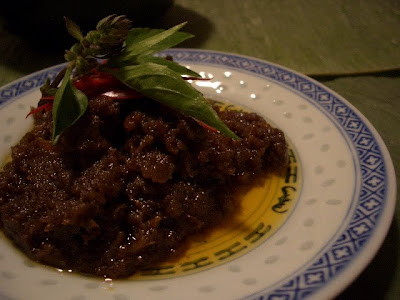This particular cookbook makes the Slow Food movement look like MacDonald’s. The author–David Thompson–having found himself in Thailand by accident some years ago, decided that its cuisine was … maybe the best thing ever. He did some serious reconnaissance, found a bunch of ancient recipes, and went from there. Thai Food is as fat as a dictionary and contains a recipe and Julia-esque length explanations for everything from fermented fish paste to coconut ash pudding.
Andrew’s been experimenting with many of its curry recipes (and they have all been absolutely fantastic) since August, but it wasn’t until this weekend that he, Rosie and I put together a full-fledged (and painfully authentic) feast. Rather than sit here and describe each dish for you, here’s the meal in images:

The night before, Andrew fried up a shallot relish in left-over duck fat. Seriously, this was probably one of the best things I have ever eaten. We recommend using long beans as relish-consuming vehicles:


Rosie (along with a bit of pounding help from Stephen) painstakingly shredded a green papaya for a salad–funky, fishy, and totally addictive:


I cracked open a young coconut (hopefully there will be pictures of this to come–Andrew took them and we can’t find his camera cable) and cooked it up with freshly picked wild chanterelles, chicken, game hen stock, deep fried garlic and thai basil. Not the most photogenic, but still yummy:

I also made the requisite coconut rice:

The highlight of the meal was certainly the Andrew’s steamed fish curry. I’m not totally sure what all went into the curry paste, but it was green, lemon-limey, and super-tasty. The best part of the curry, though, was the way that the fish (we used cod because it had the green light from Monterey Bay) melted into the sauce. It wasn’t fish in curry sauce at all–it was curry-fish with an almost pudding-like consistency. So. Good:

You’ll notice the well-constructed banana-leaf bowl in which the curry steamed:

This was Stephen’s major contribution to the feast. He just wanted me to tell you that.

No feast is complete without dessert:

Okay, pulut hitam (black rice pudding) is not exactly Thai, but it’s one of my favorite desserts and has coconut and palm sugar in it just like everything else we ate.

So full. So satisfied. I should eat real Thai more often.








